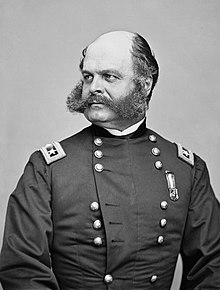Burnside's North Carolina Expedition
Burnside's North Carolina Expedition (also known as the Burnside Expedition) was a series of engagements fought along the North Carolina Coast between February and June 1862. The expedition was part of
Expedition

In August 1861, Major General
Coast Division


Being careful not to ask for reinforcements from McClellan's own
District of Roanoke
Brigadier General Henry A. Wise commanded the District of Roanoke and had a mere 1,400 men and few artillery pieces to defend his district. Besides a lack of infantry and artillery, the Confederates also lacked a significant naval force. A group of 8 work boats were converted into gunboats commanded by William F. Lynch. Wise contemptuously referred to the boats as the "mosquito fleet". Wise pleaded with his superior, Benjamin Huger in Virginia to send reinforcements. Huger declined to give aid but eventually Wise's reserves and a battalion of the 2nd North Carolina from Norfolk bolstered the defenses.[3] The Union expedition was having problems of its own. Severe weather hampered progress so much at times it seemed as if the whole mission would have to be scrapped.[4] The expedition, accompanied by 63 navy vessels, finally arrived off the coast of Roanoke Island.[5]
Roanoke Island
By the time Burnside arrived, Roanoke Island was guarded by 3,000 Confederate troops under the command of Colonel Henry M. Shaw. District commander Henry Wise remained in overall command of the forces but was confined to his sickbed at Nag's Head. Burnside and Goldsborough defeated the Confederate force and took roughly 2,500 prisoners. A few days later, the Federal navy destroyed the remnants of the Confederate "Mosquito Fleet" which had escaped from Roanoke Island.
New Bern
Burnside then returned to Hatteras Inlet and was reinforced by more ships from the navy for his next objective, the railroad town of
Burnside's main attack did not come from water. Instead he marched his three brigades up along the railroad and attacked New Bern from the south. After fighting along his breastworks, Branch's defeated Confederates fled into New Bern. Hundreds of troops continued on to the railroad depot in town and boarded an outbound train. Branch ordered the rest of his troops to fall back to Kinston to regroup.[7]
Fort Macon
Burnside's next objective after New Bern was the terminus of the
End of the Expedition
By June 1862, Burnside had occupied Roanoke Island, New Bern, Morehead City, Beaufort and Washington, North Carolina. Colonel
Aftermath
Burnside left behind General Foster in command of 8,000 troops. Foster mounted an expedition against the railroad at Goldsborough, which he destroyed at the end of 1862. The fighting in North Carolina would then devolve into a series of raids and skirmishes. In 1864, the Confederates assumed the offensive in North Carolina, trying to recover some of the territory lost to Burnside's expedition. They
Opposing forces
Union
Confederate
Battles
- Battle of Roanoke Island (February 7–8, 1862);
- Battle of Elizabeth City (February 10, 1862)
- Battle of New Bern(March 14, 1862);
- Battle of South Mills (April 19, 1862)
- Battle of Fort Macon(March 23-April 26, 1862)
- Battle of Tranter's Creek (June 5, 1862)
Forces Involved
Union
Before April 2, 1862
Coast Division – BG
- 1st Brigade – BG John G. Foster
- 2nd Brigade – BG Jesse L. Reno
- 3rd Brigade – BG John G. Parke
North Atlantic Blockading Squadron – Flag Officer Louis M. Goldsborough
- Naval Forces in Pamlico Sound — Commander Stephen C. Rowan
After April 2, 1862[9]
Coast Division – BG
- 1st Division – BG John G. Foster
- 1st Brigade – Col Thomas I. C. Amory
- 2nd Brigade – Col Thomas G. Stevenson
- 2nd Division – BG Jesse L. Reno
- 1st Brigade – Col James Nagle
- 2nd Brigade – Col Edward Ferrero
- 3rd Division – BG John G. Parke
- 1st Brigade – Col Charles A. Heckman
- 4th Brigade – Col Rush C. Hawkins
- 1st Brigade – Col
North Atlantic Blockading Squadron – Flag Officer Louis M. Goldsborough
- Naval Forces in Pamlico Sound — Commander Stephen C. Rowan
Confederate
Department of North Carolina
BG
- District of Roanoke – BG Henry A. Wise (22 Jan 1862-9 Feb 1862); Col Henry M. Shaw (9 Feb 1862-18 Aug 1862)
- District of Albemarle — BG Henry A. Wise (district abolished 23 Feb 1862)
- District of Pamlico – BG Lawrence O. Branch
Notes
References
- Burnside, Ambrose E., "The Burnside Expedition," Battles and leaders of the Civil War, Johnson, Robert Underwood, and Clarence Clough Buell, eds. New York:Century, 1887–1888; reprint, Castle, n.d.
- Chaitin, Peter M., and the Editors of Time-Life Books, The Coastal War: Chesapeake Bay to Rio Grande, Time-Life Books, 1984
- McPherson, James M., editor, "The Atlas of the Civil War", MacMillan, 1994
External links
 Media related to Burnside's North Carolina Expedition at Wikimedia Commons
Media related to Burnside's North Carolina Expedition at Wikimedia Commons
